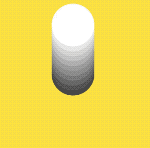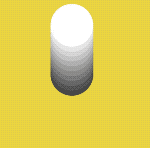 What can you see? The initial 2-dimensional image shows several discs lying on top of each other, which are coloured from black to white. When rotated, it appears as 3-dimensional; the impression of a tower is created.
What can you see? The initial 2-dimensional image shows several discs lying on top of each other, which are coloured from black to white. When rotated, it appears as 3-dimensional; the impression of a tower is created.
This phenomenon was described by Musatti in 1924 and called the stereokinetic effect. Depending on the arrangement of the static discs, the effect can be perceived more clearly.
What can you do? There are six arrangements to choose from (1 ≤ no of effect ≤ 6): tower (1), tube (2), cone (3), crater (4), cone-2 (5), diabolo (6). You can switch back and forth between these arrangements using the up/down buttons.

The speed of rotation is adjusted with the delta_angle_base slider (-360 ≤ delta_angle_base ≤ 360). A fine adjustment of the rotation in steps of 0.25 can be made with the right/left buttons. Finally, the background colour can also be changed with the bg_color slider (0 ≤ bg_color ≤ 99). With which arrangement is the effect most noticeable? What can be seen with very fast rotation (e.g. delta_angle_base > 25)?
What else can you do?  The 3d-effect is significantly enhanced when parts of the figures move in opposite direction or in same direction with different speed. How can you achieve this? If you select the Variables palette in the Snap!-programming environment, you can unhide the variables no_of_top_discs (which is the number of discs that rotate differently) and delta_angle_top (which is their speed of rotation). The corresponding sliders then appear on the stage.
The 3d-effect is significantly enhanced when parts of the figures move in opposite direction or in same direction with different speed. How can you achieve this? If you select the Variables palette in the Snap!-programming environment, you can unhide the variables no_of_top_discs (which is the number of discs that rotate differently) and delta_angle_top (which is their speed of rotation). The corresponding sliders then appear on the stage.
You can do even more! You can create your own arrangements just by adding new sets  of parameters. In the palette Variables and at the beginning of the programme code you will find the variable list_disc_parameters. It contains the sets in the form of lists: the list shift indicates the position relative to the previous disc, the list radius the size of the disc and the list color its color.
of parameters. In the palette Variables and at the beginning of the programme code you will find the variable list_disc_parameters. It contains the sets in the form of lists: the list shift indicates the position relative to the previous disc, the list radius the size of the disc and the list color its color.
The result of the set shown above is a floor lamp. Please note that the same number of values must be entered in each case!
You will also get funny and interesting results if you place several figures on the stage at the same time. The arrangement of the objects in the project below seems to be very similar to curious worms. All you have to do in the program is to make copies of the objects (i.e. the turtle) and determine their position on the stage. Have fun inventing new configurations!
Related topics: Duchamps Rotoreliefs, Mach discs, flicker colors
References:
Proffitt, D., Rock, I., Hecht, H. & Schubert, J. (1992). Stereokinetic Effect and Its Relation to the Kinetic Depth Effect. Journal of Experimental Psychology Human Perception & Performance 18 (1), 3-21. Available as download.
